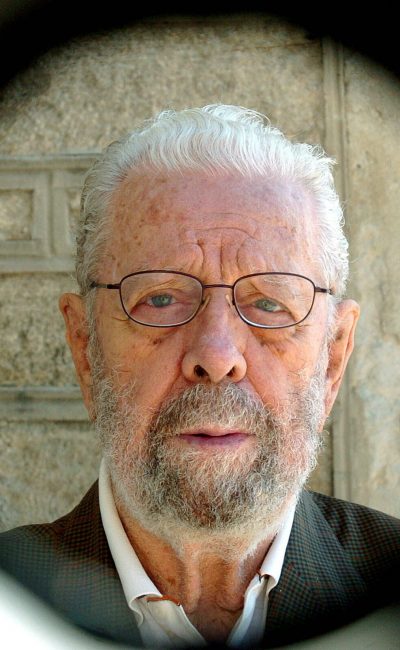Luis García Berlanga
DirectorBiografía
Berlanga commenced his studies in Valencia in1928, although in 1929 his family sent him and his brother Fernando (due to a lung disease) to the Beau-soleil hospital school in Switzerland. In 1930, he returned to the San José School in Valencia where he stayed until 1931, the year in which the Jesuits were expelled from Spain. In 1936, while he was studying at the Academia Cabanilles, the Spanish Civil War began, and he saw active service in the riflemen’s 40th Division. After the war Franco’s dictatorship imprisoned his father, then a member of the Spanish Parliament for the ‘Frente Popular’ (Popular Front). In an attempt to improve his father’s situation in jail, he joined the División Azul (Blue Division) in 1941, and fought in Russia at the Novgorod front, returning to Spain in 1942. Towards 1943 he began to take an interest in poetry and cinema, and started to write a screenplay entitled ‘Cajón de perro’, together with his first cinematographic reviews. In 1947 he entered the ‘Instituto de Investigaciones y Experiencias Cinematográficas’ (IIEC) (Institute of Cinematographic Research and Experiences). During his second year at the institute, he filmed a short entitled ‘Paseo por una guerra antigua’, {which he finished with the help of Juan Antonio Bardem, Florentino Soria and Agustín Navarro}. In 1951, he directed (together with Bardem) the film That Happy Couple (1953), starring Fernando Fernán Gómez and Elvira Quintillá. After being expelled from the Falange, Berlanga started to adopt an individualistic and libertarian position, far removed from politics and considered fairly permissive. However, his open and conciliatory nature kept him out of trouble during the post-war period. Sadly his father died six months after being released from prison. Berlanga and Bardem continued to collaborate on Welcome Mr. Marshall! (1953); this film received an International Award and a Special Mention Award at the Cannes Festival. It was also shown at the Venice Festival, where the president of the Jury, Edward G. Robinson, expressed his indignation at what he interpreted as an anti-American film. Berlanga’s conceptual and political audacity, so evident in Welcome Mr. Marshall! (1953) continued in his other films during the 50s, which tended not to be very well received by the censor. In fact, his film Miracles of Thursday (1957), was modified by the censors and was delayed for several years before its eventual release. In 1955 he participated in the ‘Conversaciones de Salamanca’ (Salamanca’s Discussions) where the future of Spanish cinema was debated. In 1956 he filmed Calabuch (1956), and in 1958 began lecturing at the IIEC. His subsequent film Se vende un tranvía (1959) was his first professional liaison with Rafael Azcona. Their next joint venture was Placido (1961), which received an Oscar nomination in 1963. That same year, Berlanga made of his best films: The Executioner (1963); however, his cruel portrait of Spanish society didn’t please the pro-Franco authorities, although the film was well-received at the Venice Festival. In 1973 he went to Paris to begin filming _Grandeur nature (1973)_, another polemic film, focussing this time on the fetishism of a man who falls in love with a doll. Several years later, after Franco’s death, he filmed a trilogy comprising La escopeta nacional (1978), National Heritage (1981) and National III (1982), where he clarified the disorders evident in the Spanish upper middle-class upon being confronted with a new political status quo. Following the same theme he filmed The Heifer (1985), set in the Spanish Civil War and also beset by difficulties with the censors. The quality of his cinematography and independence of criteria was welcomed during the years following the end of the dictatorship. In 1978 he was made president of the ‘Filmoteca Nacional’ (National Archive), in 1980 he won the ‘Premio Nacional de Cinematografía’ (National Cinematography Award), in 1982 he received the ‘Medalla de Oro a las Bellas Artes’ (Gold Medal to Arts), in 1986 he won the ‘Premio Príncipe de Asturias de las Artes’ (Príncipe de Asturias Arts’ Award), in 1988 he was named member of the ‘Real Academia de Bellas Artes de San Fernando’ (San Fernando’s Art’s Real Academy), and in 1997 he was awarded the Doctor Honoris Causa title by the ‘Universidad Politécnica de Valencia’ (Valencia’s Politechnical University). In addition he was made president of the ‘Asociación de Titulados en Cinematografía’ (Graduates in Cinematography’s Association) and he was the first president of the Academia de las Artes y Ciencias Cinematográficas de España (Spanish Academy of Arts and Cinematographic Sciences). In 1994, his film Todos a la cárcel (1993) won three Goya Awards for Best Film, Best Director and Best Sound. In 2002, the ‘Asociación de Directores de Cine’ (Cinema Directors’ Association) gave him an honorary award.

